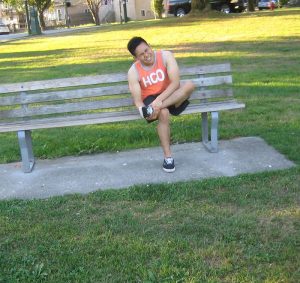Sesamoiditis is an inflammatory ailment that involves the sesamoid bones of the 1st matatarsophalangeal joint that cause forefoot pain especially during weight bearing. The sesamoid bones are small bones embedded in the tendon of the flexor hallucis brevis muscle under the bottom of the big toe.
Symptoms of sesamoiditis
- Pain in forefoot especially with weight bearing
- Tenderness over and under the surface of the joint
- Pain when walking, jumping and running
Pain in forefoot especially with weight bearing is one of the indications. - Limping when walking or shifting weight into the outside of the foot when walking.
- Pain when moving the big toe against resistance
- Inflammation and swelling of the area
- Bruising of the area
- Pain when bending and straightening of the big toe
Causes
- Traumatic fracture or damage between a bipartite sesamoid bone and movement between the sesamoid bone and metatarsal bones in the foot.
- Overuse injury caused by repetitive impact
- Increased forefoot weight bearing activities such as dancing.
- Acute changes in the direction when playing tennis, badminton, basketball and dancing.
Treatment
- Take plenty of rest and avoid performing activities that triggers pain.
- Apply an ice pack on the affected area to lessen the pain and inflammation. Ice can be in the form of a frozen bottle of water. Place the frozen bottle of water in the floor and roll the foot over the bottle for at least 20 minutes at a time and remove the ice for 20 minutes. Repeat this process several times every day. Another alternative is applying an ice pack on the sole of the foot for at least 15 minutes every 2-3 hours. Avoid applying the pack directly on the skin to prevent further damage that can worsen the condition.
- Elevate the affected area above the level of the heart to lessen the swelling.
- Wear the prescribed sesamoid relief sleeve to lessen the pressure placed on the sesamoid bones. It lessens the pressure on the foot especially when walking.
- Wear an arch support for the foot for those with pes cavus or extremely high arch.
- Wear a modified shoe or shoe pad to reduce the pressure placed on the bone and lessen the irritation. Another option is using a metatarsal pad that spreads the weight bearing points of the forefoot to lessen pain and swelling.
- Tape the big toe or use an athletic strapping to prevent unnecessary movements as much as possible and for fast healing of the condition.
- Take prescribed pain medications such as ibuprofen and naproxen to lessen the pain and inflammation.
Tips
- Regular stretching exercises for the foot and leg before performing any vigorous physical activities.
- Wear well-fitting shoes that provide good support and cushioning of the foot arches especially when performing strenuous walking and standing on hard surfaces for long periods of time.

